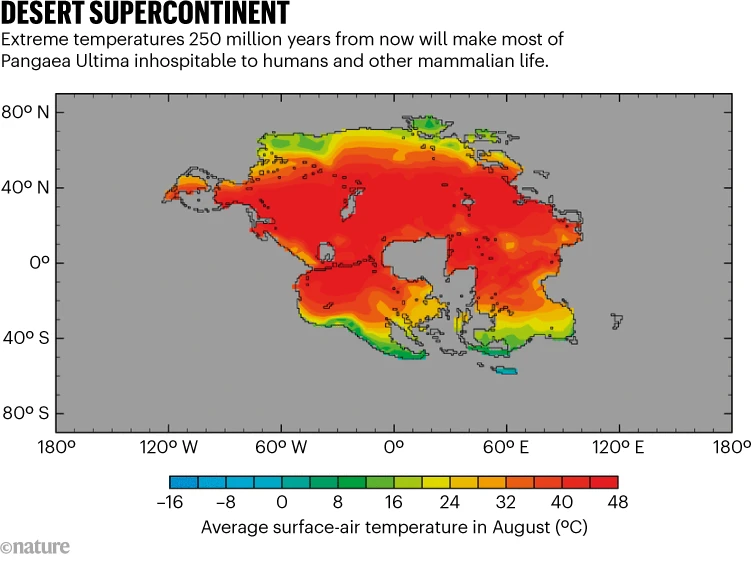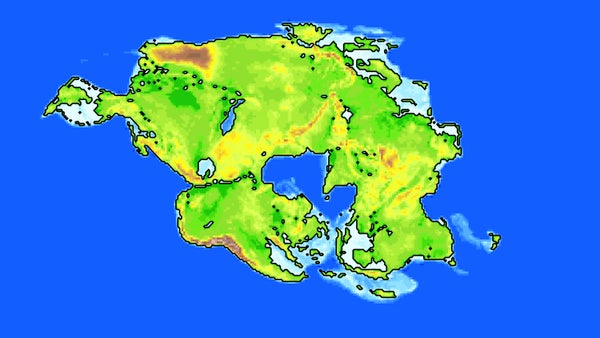Up to 92% of Earth could be uninhabitable to mammals in 250 million years, researchers predict. The planet’s landmasses are expected to form a supercontinent, driving volcanism and increases to carbon dioxide levels that will leave most of its land barren.
“It does seem like life is going to have a bit more of a hard time in the future,” says Hannah Davies, a geologist at the GFZ German Research Centre for Geosciences in Potsdam. “It’s a bit depressing.”
Earth is currently thought to be in the middle of a supercontinent cycle as its present-day continents drift. The last supercontinent, Pangaea, broke apart about 200 million years ago. The next, dubbed Pangaea Ultima, is expected to form at the equator in about 250 million years, as the Atlantic Ocean shrinks and a merged Afro-Eurasian continent crashes into the Americas.
On supporting science journalism
If you're enjoying this article, consider supporting our award-winning journalism by subscribing. By purchasing a subscription you are helping to ensure the future of impactful stories about the discoveries and ideas shaping our world today.

Credit: Nature
Modelling the climate of the new supercontinent, described on 25 September in Nature Geoscience, Alexander Farnsworth at the University of Bristol, UK, and his colleagues found that much of Pangaea Ultima will experience temperatures of higher than 40 °C, making it uninhabitable to most mammalian life. As they merge together and then drift apart, the continents will drive volcanic activity that “spews huge amounts of CO2 up into the atmosphere,” says Farnsworth, and that will heat up the planet.
Regions in the middle of the supercontinent, far from the oceans, would turn into deserts that are unliveable “expect for very specialized mammals,” says Farnsworth. The lack of moisture would also diminish the amount of silica that is washed into the oceans, which usually removes CO2 from the atmosphere.
Increased solar radiation will cause further heating. The Sun is predicted to be 2.5% more luminous at the time of Pangaea Ultima’s formation, a result of the star having burnt more of its hydrogen fuel and shrunk its core, increasing its rate of nuclear fusion.
In a worst-case scenario, in which CO2 levels reach 1,120 parts per million, more than double current levels, just 8% of the planet’s surface — coastal and polar regions — would be habitable to most mammalian life, compared with about 66% today.
This would lead to a mass extinction, says Farnsworth. “It wouldn’t just be for mammals. It could be for plant life, as well, and other types of life. What comes out of it is anyone’s [guess]. In other mass extinctions a new species tends to dominate.”
Carbon emissions caused by human activity were not considered by the researchers, who focused on long-term climate modelling.
Survival hopes
Davies, who has previously studied the formation of Pangaea Ultima, says that it is possible that some mammalian life might survive the environmental changes. “Whether or not they all go extinct is just one outcome, but it’s not the [only] outcome,” she says. It’s also not certain where Pangaea Ultima will form. Farnsworth’s modelling assumes it will coalesce in the warm tropics, but other scenarios suggest that it could form on top of the North Pole, leading to cooler conditions where life might fare better.
There is some evidence that Pangaea and other previous supercontinents had large interior deserts, says Davies, which decreased the area of habitable land and led to extinctions. “You see similar things happening in the end-Triassic extinction event” around 200 million years ago, she says.
If humans are still around in 250 million years, Farnsworth speculates that they might have found ways to adapt, with Earth resembling the 1965 science-fiction novel Dune. “Do humans become more specialist in desert environments, become more nocturnal, or keep in caves?” he asks. “I would suspect if we can get off this planet and find somewhere more habitable, that would be more preferable.”
It might not be all doom and gloom, however. “There have been extinction events in the past, and will be extinction events in the future,” says Davies. “I think life will make it through this one. It’s just kind of a grim period.”
This article is reproduced with permission and was first published on September 25, 2023.
